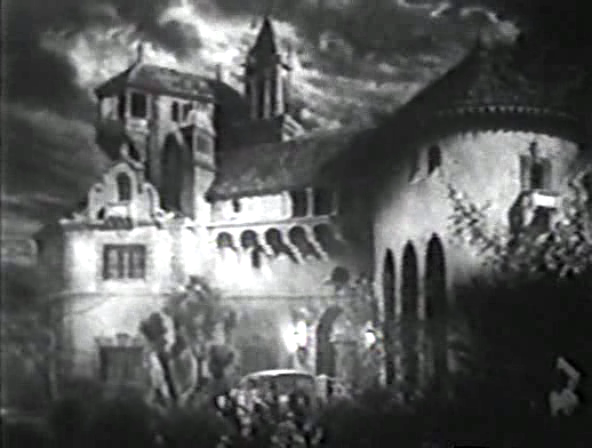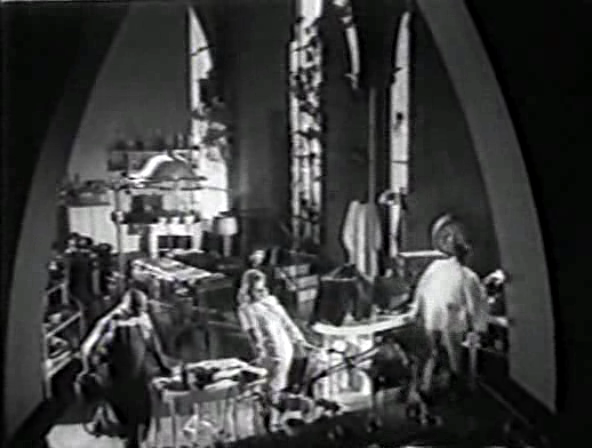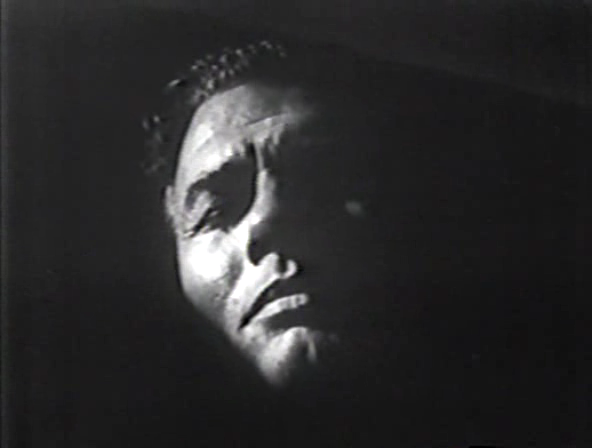Lady and the Monster, The (1944)
“Would it not be the achievement of all time to keep the brains of great thinkers, scientists, authors, statesmen, alive? To derive benefit from their wisdom and thinking power, even after their death — to make them literally immortal?”
|
Synopsis: |
|
Genres, Themes, Actors, and Directors:
Review: Part of the success of the screenplay (which eventually becomes too confusing for its own good) is in the way we’re never quite sure who’s “good” or “bad”: we know that Donovan was a fraudulent financier and an overall not-nice person, but is his motivation in getting a convicted murderer out of jail completely self-serving or not? And how far will Professor Mueller (von Stroheim) go with his project, even if it means placing Arlen’s life at increased risk? Meanwhile, the film is surprisingly hypnotic to look at (see stills below), with creepy, shadow-filled gothic sets and stunning noir cinematography by Oscar-winning D.P. John Alton. Film fanatics will likely enjoy seeing von Stroheim in a semi-leading role as mad (but-not-too-mad) Prof. Mueller, while Czech figure-skater-turned-actress Vera Hruba Ralston delivers a notoriously awful performance — fun for laughs if nothing else. The Lady and the Monster isn’t must-see viewing, but it’s certainly worth a look if you can find a copy. Redeeming Qualities and Moments:
Must See? Links: |







One thought on “Lady and the Monster, The (1944)”
First viewing. Not a must; too much working against it.
For starters, the title is misleading. It puts you in mind of a Fay Wray-like heroine, perhaps in a satin gown, being stalked by something large that’s a mountain of hair and vicious. It’s one thing for a film to not be very good but they could have at least fixed it with a title that better prepares us for what we’re going to watch – in this case, they could have gone with ‘The Bad Actress and the Disembodied Nutcase’.
Poor Ralston – coerced into acting as she was, so it’s not really her fault. We can excuse her for being duped into a film career – well, except for the fact that she did actually get in front of a camera and expect us to buy into it. The poor thing (who gets solo top-billing) comes off like a graduate of the Ed Wood School for the Performing Arts. She’s hopeless.
On the plus side:
Though his role has little color as written, von Stroheim is effective with his hints of what would come in his signature performance in ‘Sunset Boulevard’. Arlen – doing double-duty – is appropriately spooky when the brain takes mental control of him, thus turning him into Lawrence Tierney. DP Alton, as well, is responsible for most of the film’s success – though occasionally he over-compensates for the less-than-tight script. (In the sequence in which he visits a prison to try to get someone out, Arlen’s look is so intensely noir that you expect the inmate to say, ‘You are really creeping me out; what’s with the stylized lighting?’)
Director George Sherman made a ton of westerns prior to this – and another ton after; his work reads like he was not all that comfortable in this genre. But, then, it’s not easy when you have a script that spends half its time meandering before it kicks in. It also didn’t help that the pages were peppered with equally exasperating dialogue. Take this exchange – when Arlen reports on the brain communicating through him:
Arlen: Of course it was written by me! But it’s the exact signature of W. H. Donovan! Don’t you see the scrawl, the hard ‘H’ and the flourish on the end?
von Stroheim: And you’ve written it with your left hand. But, still, that isn’t sufficient proof that it was Donovan’s brain that influenced you telepathically. You and I happen to have read Donovan was left-handed. And
you have seen his signature facsimile in some magazine. So, therefore, it could be auto-suggestion or self-hypnosis.
Ralston: (thinking Arlen, though a doctor, is unfamiliar with the term ‘auto-suggestion’) Patrick…what Professor Mueller is trying to tell you is that your imagination is running away with you.
Odd but this version of Siodmak’s novel is still better than the 1952 American remake – which (though it has a few significant changes) has no real heightened style, has a not-very-menacing Lew Ayres in the Arlen role, and has (eek!) Nancy (Davis) Reagan standing in for Ralston: she had a little more knack for word emphasis but she still seems a mere baby-step above Ralston – like she graduated from the Wood School with honors.
[Sidenote: Almost anything about brains or with ‘brain’ in the title has a tendency to be fun or fun/bad: as witness ‘The Brain from Planet Arous, ‘The Brain That Wouldn’t Die’ and what may be Carl Reiner/Steve Martin’s best film, ‘The Man With Two Brains’.]